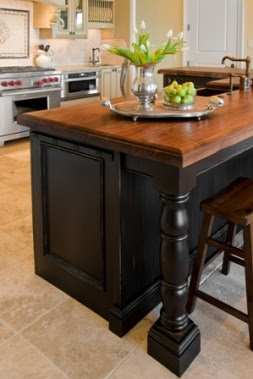In the world of kitchen design, one of my biggest pet peeves is outlets in the island. I know, code requires you to have at least one outlet, and they can be functional for prep spaces. So they are a necessary evil. I say evil because standard outlets can be just plain ugly. For example, see the photo above. Maybe it's just me, but when I look at that photo, all I see is that ugly white rectangle on the island. Once I finally convince myself to look beyond the outlet, then and only then do I see that it's actually a very nice kitchen. But, that outlet... I just can't get past that outlet! The sad thing is that there are many device colors available. So for just a few dollars more (and no extra creativity), they could have used a black outlet and cover plate that would have blended in so much better! Lutron also has about 20 other colors available.
I'm constantly on a mission to find a better solution for outlets in islands, rather than the standard duplex outlet box. So far, here's what I've come up with:
1. Plugmold strips. These can sometimes be recessed into an end panel, or tucked up underneath the countertop overhang.
via Kitchen Details blog
2. Kitchen Power Grommet by Mockett.
I love this concept, though I haven't actually used it yet. This pop-up grommet has a seal, supposedly making it safe for wet locations. When you need an outlet, you simply pop up the unit and you then have all the outlets you need right in front of you. Beware though, this is a pretty big unit so you need to make sure you have room in the cabinet below the grommet, since it will take up space. (UPDATE: I have used this outlet since I originally posted, and as long as it's installed properly, it's a great solution. Though I'll emphasize again that it is a bit bulky and takes up a bit of space below the countertop.)
3. Sillite. I'm pretty excited about this one! In fact, I'm working with an electrician right now to use a Sillite outlet in a kitchen island, and I think it's going to work great. (Thanks Jayson for being willing to try new things!)
If you know of other creative alternatives, please share!
Disclaimer: I'm not entirely sure if all of these applications will pass code in your area. Though the websites claim they meet code, it's up to each jurisdiction (and each individual inspector) to confirm. So please check with local building inspectors before using any of these options.
7/12/12 UPDATE: I just posted a photo of a Lutron designer color outlet we installed on an island. The color blends almost perfectly, and the screwless plate has a finished look. See the full post here.
11/23/2013 UPDATE: Legrand now has a line of outlets approved for use in the US which use stylish square receptacles with several options for faceplates, including this one I custom-designed for a recent contest (I didn't win, but it was fun anyway).











Cool! I like the idea of the pop up one, probably more than I would like the actual product. :) But the Sillite is just sweet!
ReplyDeleteEVOline from Germany is now available in the USA. www.EVOline-usa.com has many finishes, 15A 125 VAC, CSA approved. Fast friendly delivery!
ReplyDeleteI'm an electrician (Connecticut, USA), and have to reiterate your cautions regarding local codes. Love the wiremold and sillite ideas - just keep in mind that kitchen outlets have to be GFCI protected, and on a 20 amp circuit. I see do-it-yourself nightmares all the time. Work with your local professionals - sometimes the codes are a pain in the buns, but overall they're designed for safety.
ReplyDeleteGreat point. Proper wiring should be done by a professional to ensure safety!
DeleteAnother tradesman worried about his job, pathetic. This is very easy to do if your already handy. 20a breaker > 20a GFCI > to exterior outlets. Just remember to hook up the GFCI correctly
DeleteRespect and that i have a nifty offer: How Much House Renovation Cost Philippines outdoor home renovations
ReplyDeleteThe Sillite outlets sound like an innovative solution for kitchen islands.
ReplyDelete